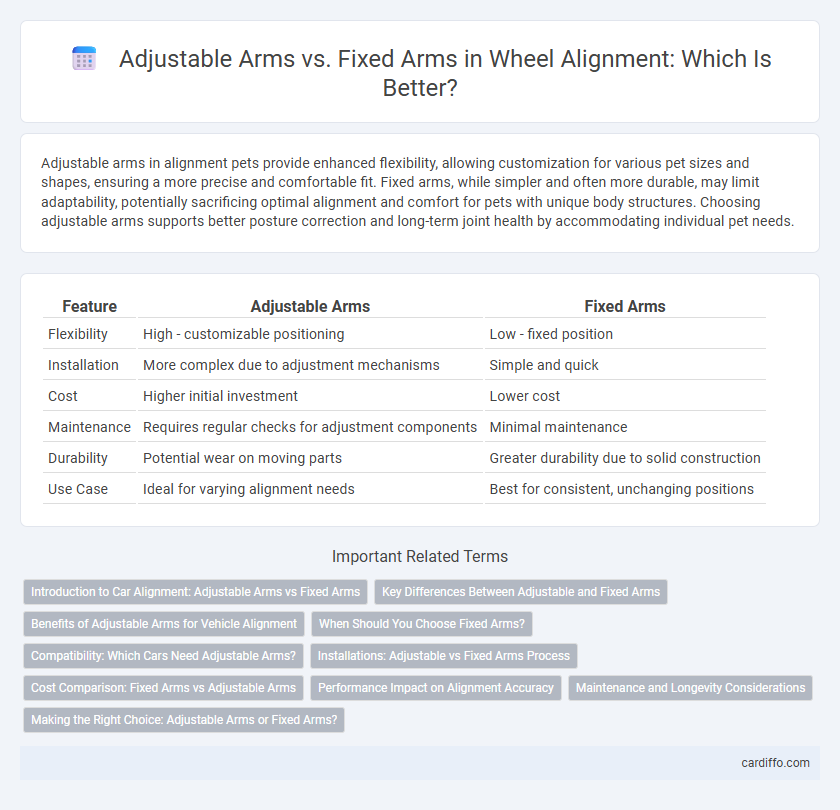Adjustable arms in alignment pets provide enhanced flexibility, allowing customization for various pet sizes and shapes, ensuring a more precise and comfortable fit. Fixed arms, while simpler and often more durable, may limit adaptability, potentially sacrificing optimal alignment and comfort for pets with unique body structures. Choosing adjustable arms supports better posture correction and long-term joint health by accommodating individual pet needs.
Table of Comparison
| Feature | Adjustable Arms | Fixed Arms |
|---|---|---|
| Flexibility | High - customizable positioning | Low - fixed position |
| Installation | More complex due to adjustment mechanisms | Simple and quick |
| Cost | Higher initial investment | Lower cost |
| Maintenance | Requires regular checks for adjustment components | Minimal maintenance |
| Durability | Potential wear on moving parts | Greater durability due to solid construction |
| Use Case | Ideal for varying alignment needs | Best for consistent, unchanging positions |
Introduction to Car Alignment: Adjustable Arms vs Fixed Arms
Car alignment systems utilize adjustable arms to provide precise control over wheel angles, enhancing vehicle stability and tire longevity. Fixed arms offer a simpler, more durable setup but lack the fine-tuning capabilities necessary for optimal alignment adjustments. Understanding the distinction between adjustable and fixed arms is crucial for selecting the appropriate alignment method tailored to specific vehicle requirements.
Key Differences Between Adjustable and Fixed Arms
Adjustable arms offer customizable positioning, allowing precise alignment tailored to individual needs, whereas fixed arms maintain a constant position with no flexibility. The key difference lies in adaptability; adjustable arms improve ergonomics and comfort by supporting varied postures, while fixed arms provide simplicity and consistent support. Choosing between adjustable and fixed arms depends on the balance between versatility in alignment and structural stability.
Benefits of Adjustable Arms for Vehicle Alignment
Adjustable arms in vehicle alignment provide enhanced precision by allowing technicians to fine-tune suspension angles, improving overall handling and tire wear. These arms accommodate a wider range of vehicle models and suspension types, increasing versatility in alignment shops. Improved adjustability also reduces the need for aftermarket modifications, saving time and costs during alignment procedures.
When Should You Choose Fixed Arms?
Fixed arms are ideal for alignment tasks requiring maximum stability and precision due to their rigid, non-movable structure, which minimizes measurement errors. They are preferred when working on vehicles with standard suspension setups where consistent and repeatable positioning is crucial. Choosing fixed arms enhances the accuracy of toe, camber, and caster adjustments during wheel alignment procedures on most passenger cars.
Compatibility: Which Cars Need Adjustable Arms?
Adjustable arms offer superior compatibility for vehicles with modified suspensions, allowing precise alignment adjustments essential for performance cars, off-road vehicles, and lowered or lifted trucks. Fixed arms suit stock or minimally altered vehicles where standard caster and camber angles meet manufacturer specifications. Cars requiring frequent alignment tuning or enhanced handling benefit most from adjustable arm installations, ensuring optimal tire wear and steering response.
Installations: Adjustable vs Fixed Arms Process
Adjustable arms simplify installation by allowing precise alignment adjustments on-site without removing or repositioning the entire assembly, reducing labor time and error potential. Fixed arms require exact measurements and alignment during initial setup, increasing the risk of misalignment and necessitating rework if errors occur. The flexibility of adjustable arms enhances efficiency and accuracy in complex installations where site conditions may vary.
Cost Comparison: Fixed Arms vs Adjustable Arms
Fixed arms generally offer a lower upfront cost compared to adjustable arms, making them a budget-friendly option for basic alignment tasks. Adjustable arms, while more expensive initially, provide greater versatility and precision, potentially reducing long-term costs through improved accuracy and fewer rework cycles. Investing in adjustable arms can lead to higher efficiency and cost savings in complex or frequent alignment operations.
Performance Impact on Alignment Accuracy
Adjustable arms allow for precise customization of camber, caster, and toe settings, significantly enhancing alignment accuracy by accommodating unique suspension geometries and vehicle dynamics. Fixed arms, while simpler and more durable, limit fine-tuning capabilities, potentially causing suboptimal alignment and uneven tire wear over time. Performance gains with adjustable arms manifest in improved handling, tire life, and overall vehicle stability during dynamic driving conditions.
Maintenance and Longevity Considerations
Adjustable arms in alignment systems allow for easy calibration and fine-tuning, reducing maintenance time and costs while enhancing longevity by adapting to wear and environmental changes. Fixed arms, though simpler and less expensive initially, may require more frequent replacements or repairs due to their inability to accommodate adjustments, potentially impacting long-term durability. Choosing adjustable arms improves system resilience and reduces downtime, optimizing maintenance efficiency and extending operational lifespan.
Making the Right Choice: Adjustable Arms or Fixed Arms?
Choosing between adjustable arms and fixed arms in wheel alignment depends on the vehicle's application and precision requirements. Adjustable arms offer enhanced flexibility for fine-tuning camber and caster angles, ensuring optimal tire wear and handling performance. Fixed arms provide simplicity and durability, ideal for standard alignment jobs where minimal adjustments are needed.
Adjustable Arms vs Fixed Arms Infographic

 cardiffo.com
cardiffo.com